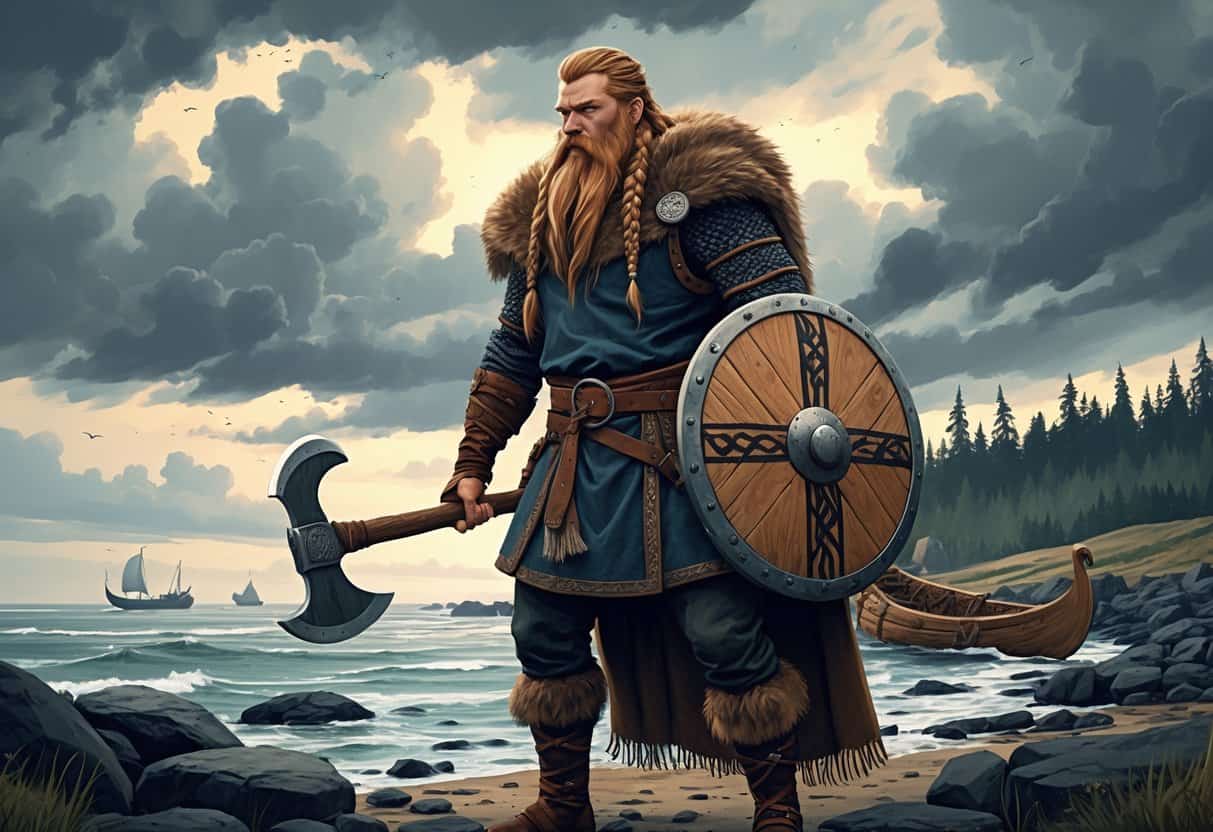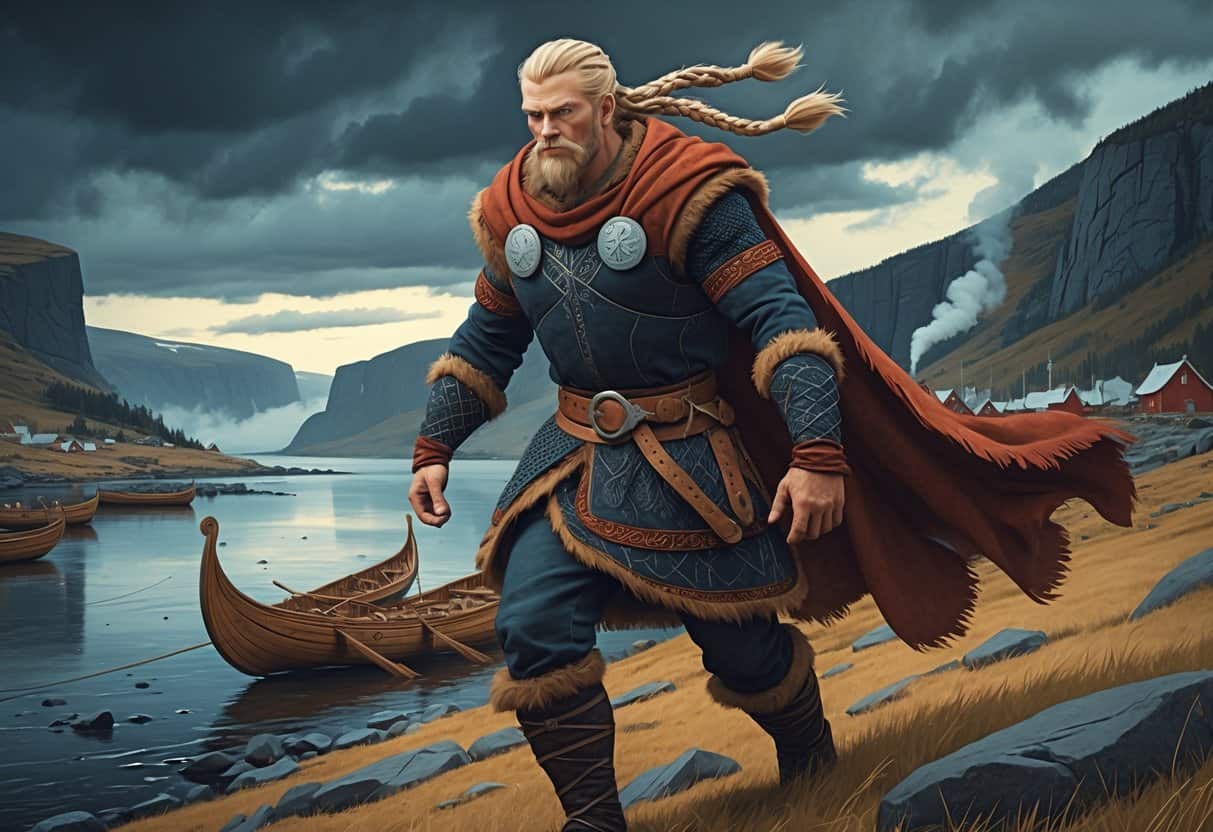Ivar the Boneless was a Viking leader who made his mark during the Viking Age. He was a son of the legendary Viking king Ragnar Lothbrok and led important military campaigns in England and Ireland.
His nickname, “the Boneless,” has sparked much debate. It points to something unusual about his physical or medical condition.

You’ll find stories about Ivar’s early life, his rise to power, and the impact he had on the Viking world. His story is a wild mix of real historical events and legendary tales.
If you’re curious about how one of Scandinavia’s most famous Vikings influenced history, you’re in the right place.
Key Takeways
- Ivar was a key Viking leader known for invasions in England and Ireland.
- His life mixes true history with legend from the Viking Age.
- Ivar’s legacy remains a strong part of Viking cultural history.
Early Life and Historical Context

To get Ivar the Boneless, you have to look at his family, his era, and the sources that mention him. His background is tangled up with other famous Vikings.
The records about him come from old texts and archaeology, but they’re not always clear.
Origins and Family Background
Ivar the Boneless is said to be the son of Ragnar Lothbrok, a legendary Viking king from Scandinavia. Ragnar’s wives, like the shieldmaiden Lagertha and Aslaug, are part of his story.
Ivar had brothers named Ubbe, Björn, and Hvitserk, who also show up in Viking tales.
His surname, “Boneless,” definitely stands out. Some say it hints at a health problem or a weird physical trait.
We can’t be sure, but he was a key leader in Viking raids.
Scandinavian Society and Culture
Viking society back then was split into classes: jarls (nobles), karls (free farmers and warriors), and thralls (slaves). Most people were farmers, but plenty joined raids or traded.
The Vikings followed pagan gods like Odin and Thor. Their culture leaned on Old Norse language and storytelling—sagas, poems, all that stuff.
You see their ways pop up in both Viking and Anglo-Saxon records.
Sources and Historical Evidence
Most of what we know about Ivar the Boneless comes from Old Norse sagas, the Anglo-Saxon Chronicle, and medieval Latin writings. These sources blend fact and legend, so it’s tricky to pin down the truth.
Archaeology in Denmark and England brings in physical evidence of Viking activity during Ivar’s time. Institutions like the University of Cambridge dig into these sources to piece together his story.
Key sources include:
| Source Type | Examples | Notes |
|---|---|---|
| Old Norse Sagas | Tale of Ragnar Lothbrok | Blend history and myth |
| Anglo-Saxon Chronicle | English records of Viking raids | Contemporary but biased |
| Archaeological Finds | Viking graves and artefacts | Physical evidence of Viking life |
Achievements and Military Campaigns
Ivar the Boneless played a big part in the major Viking military efforts in Britain. His actions shaped the history of Anglo-Saxon England.
You’ll see how he led the Great Heathen Army, fought in major raids and battles, and left a mark on Viking control in parts of England.
The Great Heathen Army
Ivar was one of the leaders of the Great Heathen Army, a massive Viking force that invaded England in 865 AD. Warriors from Denmark and other Nordic regions joined in, aiming for Anglo-Saxon kingdoms.
The invasion led to the capture of places like East Anglia and Northumbria. Ivar’s leadership—along with his brothers—brought coordination and a lot of muscle.
This army disrupted local rule and shook up Anglo-Saxon power. Their arrival kicked off a long stretch where Viking power just kept growing in England.
Towns and monasteries got hit hard, with treasures like silver, metalwork, and jewelry taken.
Key Viking Raids and Battles
Ivar’s forces raided towns, monasteries, and settlements across England and Ireland. These raids weren’t just about fighting—they were about grabbing wealth: silver, spices, glass, pottery.
Notable battles like the Battle of Brunanburh and the Battle of Assandun really changed the game between Vikings and Anglo-Saxons. These clashes shifted who controlled what.
The Vikings tangled with kings like Alfred the Great of Wessex. Alfred pushed back against Viking advances but also ended up making treaties, giving Vikings control over parts of England—the Danelaw.
Conquests and Rule in England
After all those raids and battles, Vikings settled in parts of England, especially in areas like the Danelaw, which included Northumbria and East Anglia.
These settlements changed local culture and governance. Viking campaigns helped set up new trading centers and spread Nordic culture, even changing land use and laws.
Anglo-Saxon rulers like Alfred the Great tried to take power back. Despite the pushback, Vikings held onto influence in England for years, shaping its history and the beginnings of what would become the English nation.
Legacy, Legends, and Cultural Impact
Ivar the Boneless left a mark on history with his raids and leadership. His story is tangled up in both fact and legend.
He shaped Viking and English history, connecting to big names and events.
Historical and Legendary Reputation
Ivar’s reputation is a tricky mix of truth and myth. He was the son of Ragnar Lodbrok, a famous Viking leader.
Most of what you hear comes from Norse sagas—part history, part wild storytelling. Ivar is remembered as a skilled raider, leading invasions into England and Ireland.
His nickname, “Boneless,” is still debated. Some guess he had a disease that made his bones weak. Others think it means he was agile or maybe missing bones.
Legends paint Ivar as ruthless and clever, which helped him lead Vikings after Ragnar’s death. It’s tough to sort out what’s real and what’s just a good story.
Ivar the Boneless in Modern Media
You’ll spot Ivar in a bunch of TV shows and books about Vikings. The History Channel’s Vikings series really boosted his fame.
The show gives him a strong personality, though sometimes it gets the history wrong on purpose for drama. In modern stories, Ivar often shows up as a symbol of Viking power and mystery.
But let’s be real—most of this is historical fiction, mixing facts with entertainment. Other media, like documentaries, try to dig into the real Ivar using archaeology and history.
Still, portrayals vary, so you’ve got to watch out for what’s fact and what’s just a good yarn.
Influence on Viking and English History
Ivar’s impact shows up all over the Viking Age and early English history. He helped lead Viking invasions that really shook up medieval Scandinavia and Great Britain.
You can tie him directly to big moments, like when Vikings first landed on the English coast in the 9th century. His actions influenced rulers such as Sweyn Forkbeard and Canute the Great.
These later leaders left their own mark on England’s future. The Viking raids kicked off a chain of conflicts that eventually led to the Norman Conquest—look at the Bayeux Tapestry and you’ll spot the echoes.
Ivar’s story weaves into the bigger struggles between Vikings and Christians back then. His legacy still shapes how we think about Viking culture and the tangled history of medieval Europe.